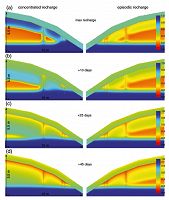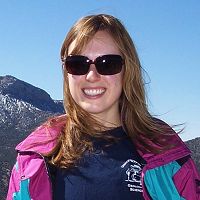VS2Di
Using VS2Di to study aspect-related controls on vadose-zone moisture
2D model of subsurface moisture dynamics in the vadose zone. Model written by R. Healy, USGS.
Model Category: Numerical
Image: Degree of saturation of the entire model domain for the concentrated and episodic model experiments. The model domains are the same size (5.5 m high, 10 m wide). The water table developed 1 m above the bottom boundary and did not fluctuate significantly during the entire model period. (a) Models on the last day of recharge in the model year. (b) Model domains 10 days after the last recharge event. (c) Model domains 25 days after the last recharge event. (d) Model domains 45 days after the last recharge event. Figure 10 from Langston, A. L., Tucker, G. E., Anderson, R. S., & Anderson, S. P. (2015). Evidence for climatic and hillslope‐aspect controls on vadose zone hydrology and implications for saprolite weathering. Earth Surface Processes and Landforms.
-
Boulder, INVESTIGATOR
-
Boulder, GRAD STUDENT
-
Boulder, INVESTIGATOR
-
Boulder, INVESTIGATOR
Through the delivery of water in snowmelt, climate should govern the rate and extent of saprolite formation in snow-dominated mountain watersheds, yet the mechanisms by which water flows deeply into regolith are largely unexplored. We used BcCZO data, in conjunction with a model of water movement in soil and saprolite, to link rainfall, snow depth, and water content data from both soil and shallow saprolite to document vadose zone dynamics in two montane catchments over 2 years. Measurements of snow pack thickness and soil moisture reveal strong contrasts between north- and south-facing slopes in both the timing of meltwater delivery and the duration of significant soil wetting in the shallow vadose zone. Despite similar magnitudes of snowmelt recharge, north-facing slopes have higher sustained soil moisture compared to south-facing slopes. To help interpret these observations, we use a 2D numerical model of vadose zone dynamics (VS2D) to calculate the expected space–time moisture patterns on an idealized hillslope under two wetting scenarios: a single sustained recharge pulse versus a set of short pulses. The model predicts that the duration of the recharge event exerts a stronger control on the depth and residence time of water in the upper unsaturated zone than the magnitude of the recharge event. Model calculations also imply that water should move more slowly through the subsurface and downward water flux should be substantially reduced when water is applied in several pulses rather than in one sustained event. The results suggest that thicker soil and more deeply weathered rock on north-facing slopes may reflect greater water supply to the deep subsurface.
Publications
2015
Evidence for climatic and hillslope-aspect controls on vadose zone moisture and saprolite weathering. Langston, A. L., Tucker,G. E., Anderson, R. S. and Anderson, S. P. (2015): ESPL, 40 1254-1269
Explore Further





